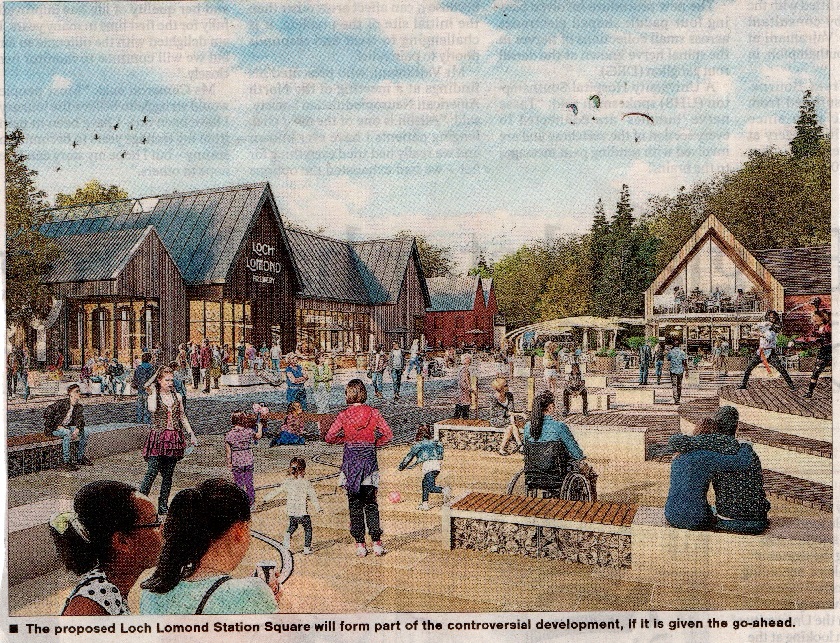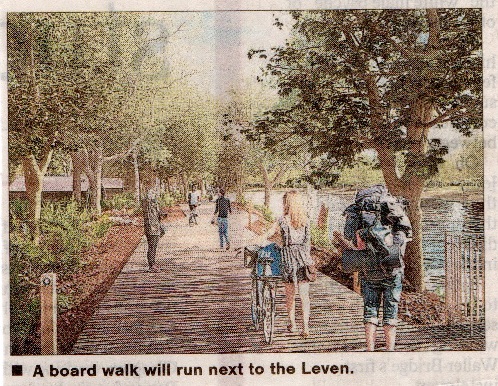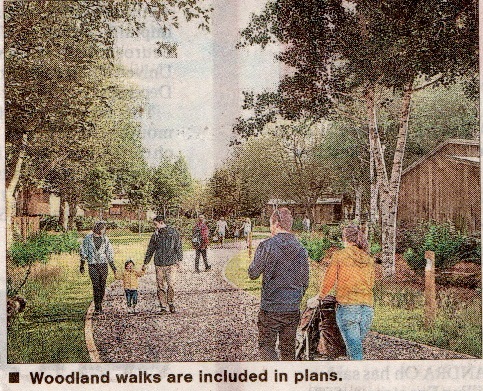
On Monday the Loch Lomond and Trossachs National Park Authority re-advertised (see here) the Flamingo Land Planning Application and announced a new statutory 28 period for the public to respond. The reason for this is that Ian Cowan, the consultant commissioned by Ross Greer and the Greens whose work has been financed by a crowdfunding appeal, had raised serious concerns about the adequacy of the entire consultation process surrounding the application (see here). The LLTNPA has tried to dismiss this in their response to Ross Greer, MSP, (see here) claiming the whole consultation process has been “robust and compliant”. This flies in the face of the evidence: the 55,000 objections to Flamingo Land are not the consequence of the Developer and National Park’s attempts at consultation but of activitists who have gradually revealed the real nature of the development. The LLTNPA have, however, admitted to an “administrative error” in how the revised application was advertised, hence the new advert:
“Notice is hereby given that an environmental statement and additional information in relation to the environmental statement have been submitted to the Loch Lomond & the Trossachs National Park Authority by Flamingo Land Limited and Scottish Enterprise relating to the planning application described below.” [Bold as in advert]
A small victory and preliminary return for all those who helped crowd fund the specialist legal advice. It also creates further time for people to lodge detailed objections and sets an important precedent because the LLTNPA has published their response to Ian Cowan/Ross Greer on the Planning portal. Indeed they did so on the very day they wrote the letter (i.e. before Ross Greer could have received it). If they can do this for objectors, why can equally well publish all their communications with Flamingo Land. Transparency needs to work both ways.
The strategic issue at stake is whether the LLTNPA and ultimately the Scottish Government will put the interests of People and Places before those of developers. Flamingo Land has ramifications for the whole Planning System in Scotland and forms a test case for the Planning Bill currently being considered by the Scottish Parliament. Its becoming very obviously “political” – not the same as party political – and that is forcing Flamingo Land to defend their proposals publicly rather then hide behind the pseudo-consultation process in which nothing was explained properly.
Flamingo Land’s most recent claims
The critical coverage by Kevin McKenna in the Herald (see here) and others has left Flamingo Land little choice but to respond publicly. Yesterday a piece appeared in the Herald (see here), written by the Herald’s Chief Reporter, David Leask, setting out Flamingo Land’s justification for the development. It has all the hallmarks of a “right of reply”. The mis-information fed to the Herald by Flamingo Land’s Andy Miller, who is humorously described as “the reason why there is a red band across the for sale sign” on the Riverside Site, is significant.
Andy Miller appears to have claimed to Mr Leask that he and employers at Flamingo Land have “stayed out of the politics” until now. That is far from the truth and depends on what you call politics. Mr Miller appears to have spent a large amount since he started to work for Flamingo Land lobbying local businesses, voluntary organisations and politicians for their support. To give one example, there was a public meeting of West Dunbartonshire Council last Tuesday about the proposals and people present reported that it appeared that Mr Miller already knew some of the councillors very well. Working the system is politics, its just politics behind the scenes.
Andy Miller then tried to argue that “good people have it got it wrong” and mistakenly believe that “the land was some kind of “public” nature reserve teeming with wildlife and what is proposed is a theme park”. Actually, while some people have objected to the development because of its likely impact on wildlife, I don’t know of anyone who claims its “teeming with wildlife“. The concern of most people is far more about the over-development of what is now green space at the gateway to the National Park. Supporters of the development have persisted in portraying a large chunk of the Riverside Site as a brownfield site or derelict, with the implication its worthless. That may explain why Mr Leask, after his interview with Andy Miller, introduces the site as “the old railway sidings and part of a former dyeworks“. That’s historically true but most of its now a public park, landscaped at public expense.
As for Andy Miller’s claim that people are “signing up for things they are not fully understanding”, that’s perfectly true. What he didn’t say is that Flamingo Landbears the main responsibility for this. It has used the Planning system, which allows Applications for Planning Permission in Principle, to avoid making public details of what it would actually like to do. At the meeting at West Dunbartonshire Council Flamingo Land’s representatives weren’t even able to say how many storeys there would be at the proposed hotel opposite Drumkinnon Tower, let along what it might look like. Its therefore impossible for even the most informed critics to “fully understand” Flamingo Land’s proposals. The more that has been revealed, however, the more uneasy people have become.
While walking round the site, Andy Miller is reported as pulling artists impressions out of a folder. Some of these are featured in the Herald article, with pride of place given to the one uncontroversial part of the development at Station Square (photo above). Andy Miller appears to have failed to point out that this comprises a small part of the total development, perhaps 5% of the land. Its also the main part of the development that has been informed by public consultation through the Balloch Charrette (community consultation event) (see here). Flamingo Land now appears to be trying to use this to justify all the other parts of its proposals. Its funny how while detailed artists impressions are provided of the buildings at Station Square, few detailed artists impressions are given for the other buildings.

Parkswatch has previously commented that one reason why the Riverside Planning Application has been so delayed is that the LLTNPA has been trying to persuade a walkway along the River Leven in its proposals. The original planning application had ruled out this proposal, another idea which has emerged from the Balloch Charrette. I was surprised, however, to see this artists impression and caption had been supplied by Flamingo Land to the Herald. There are no documents I can find in the revised application about a Board Walk. Moreover, on 20th May the Scottish Environment Protection Agency (see here) wrote to the LLTNPA withdrawing their objection to part of the development being situated on a flood plain but with a number of provisos, including this:
“Buffer strips/ no development zones
1.1 We would emphasise that there is a requirement on the developer to ensure appropriate buffer strips are maintained adjacent to all the watercourses identified within the development area, this is required in order to maintain and promote riparian habitat. This requirement could have implications for the walkway that is being considered directly adjacent to the Leven water. We would recommend further details on these works are provided for assessment and discussion with SEPA.”
How is this compatible with the information Andy Miller handed to the Herald which claims a Board Walk “will run next to the Leven”. Who has made that decision? Have SEPA done an about turn in the last two weeks or have Flamingo Land and the LLTNPA agreed a secret deal behind SEPA’s back?

“We want people to let people enjoy what they already enjoy” was another claim Andy Miller made to David Leask. How is walking through a chalet park the same as walking through undeveloped green space? “No-one will be blocked off” – really? Even if one doubts that claim, who would want to walk up to a chalet door?
David Leask let Andy Miller fall on his own sword, as it were, with his final question. “Will the site – which has gone wild since the 1980s – be as green as it is now”? “Yes, said Mr Miller”.
Here, for reference is Flamingo Land’s own description of what is proposed in its revised design statement:
• Refurbished visitor information building;
• 60-bedroom Apart-hotel;
• 32-bedspace budget accommodation;
• Up to 126 self-catering lodges comprised as follows:
• 15 woodland bothies (in grounds of Woodbank House)
• 16 woodland lodges (in grounds of Woodbank House)
• 19 Larger Lodges (in grounds of Woodbank House)
• 32 Lodges in Drumkinnon Wood
• 44 Lodges at West Riverside
• Up to 6 private houses;
• Up to 15 apartments within Woodbank House
• Up to 6 apartments within the refurbished outbuildings
of Woodbank house;
• 900m2 brewery;
• A boathouse c.95m2 for storage of equipment and
operation of water-based activities;
• Leisure/pool/water park area up to approximately
2,500m2 ;
• Restaurants/Cafe & Retail areas up to 1,100m2 in total;
• Visitor reception areas & hub building up to approximately
2,000m2;
• External activity areas including tree top walk, events/
performance areas, children’s play areas, monorail, forest
adventure rides, picnic / play areas;
• Staff and service area of up to approximately 900m2;
• Associated parking (up to 320 additional spaces),
landscaping and infrastructure development works; and
• Access to be taken from the surrounding road network
including Ben Lomond Way and Pier Road.
Greener? My foot!
The meeting at West Dunbartonshire Council
The misleading claims made by Flamingo Land to the Herald aren’t the only examples that have emerged since they have been forced to try and justify their proposals to the public.
According to reports to parkswatch, there were further examples given to Councillors at a meeting held in public with West Dunbartonshire Council on 28th May (I have already referred to the architects at this meeting being unable to say how many storeys there would be in the building).
In response to questions from Councillors about pay rates, Andy Miller apparently claimed that Flamingo Land had now agreed to pay the Scottish Living Wage – that would be a step forward – but had no control over what contractors might pay. That’s rubbish. Flamingo Land, like any private organisation, is perfectly free to stipulate pay and conditions to contractors.
He also apparently claimed at the meeting that Scottish Enterprise could have excluded the public from the Riverside Site had they wanted. The implication, I suppose, being that by retaining public paths through the site Flamingo Land is somehow improving access. That shows a complete misunderstanding of access rights. This is green space and as such access rights apply. If the development goes ahead both green space and the amount of land where access rights apply will reduce.
Following the meeting, Councillor Jim Bollan, wrote an excellent article for the National about the whole Flamingo Land proposal highlighting further problems about what had been said at the meeting (see here).
Where next?
Flamingo Land is now very much a national political issue which is receiving widespread coverage from the mainstream media. As that happens, and Flamingo Land is forced to try and justify their proposal in public, their case and that of Scottish Enterprise continues to unravel.
This creates an enormous headache for the LLTNPA, who helped appoint Flamingo Land as preferred developer. I will still, however, be surprised if they reject the development on planning grounds because of the loss of face that will bring. That, however, is what needs to happen if people in Scotland are to have any faith in the planning system or our National Parks

Shocking state of Affair
Let’s face it Developers can change their minds or even lie. They can close rights of way through private development. The local community must walk around the development to get back to the original track. Flamingo land are going to change their plans for there own profit.